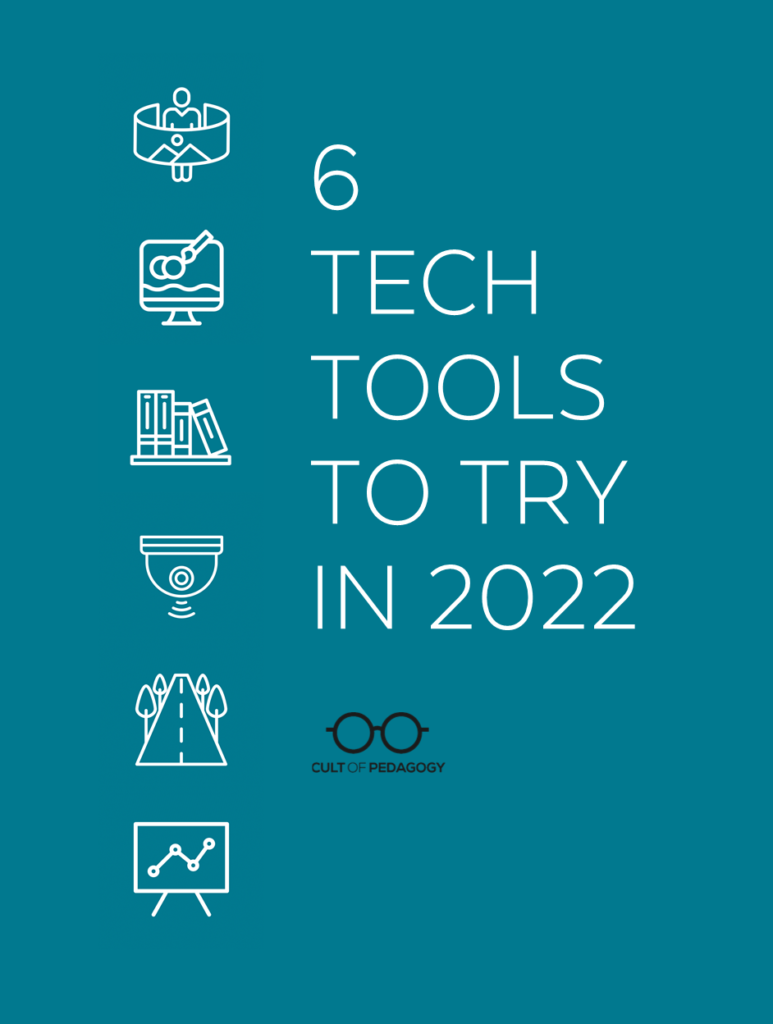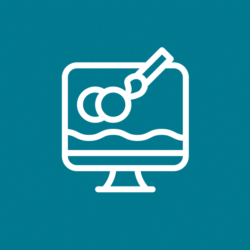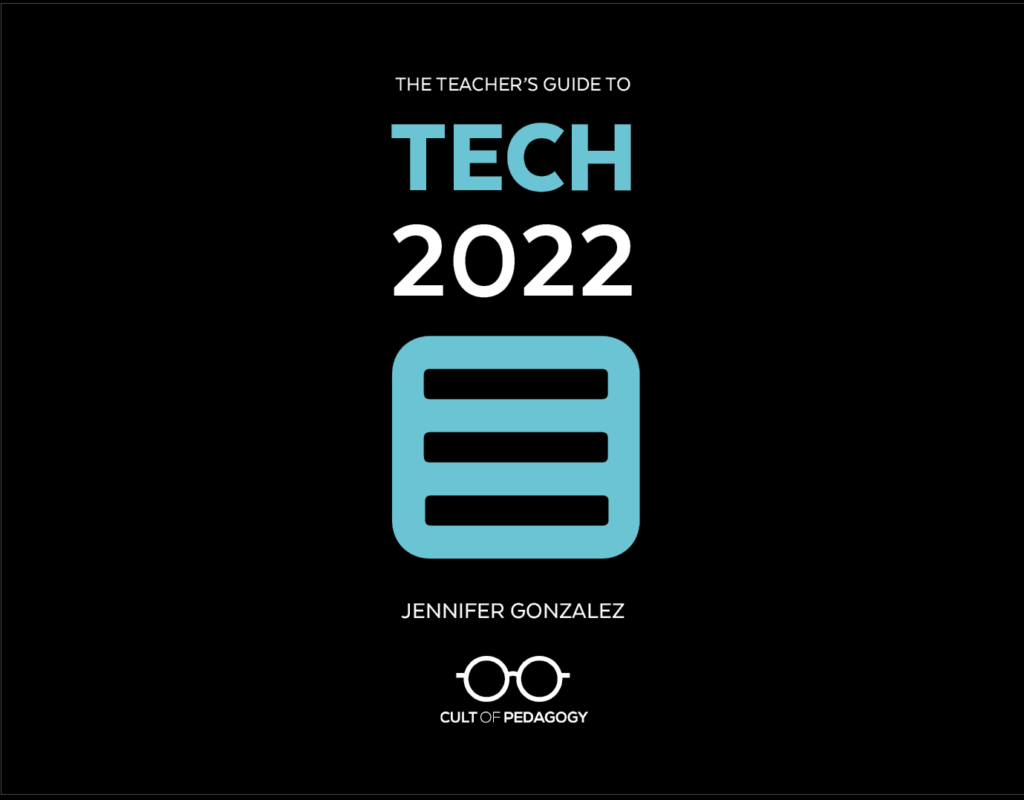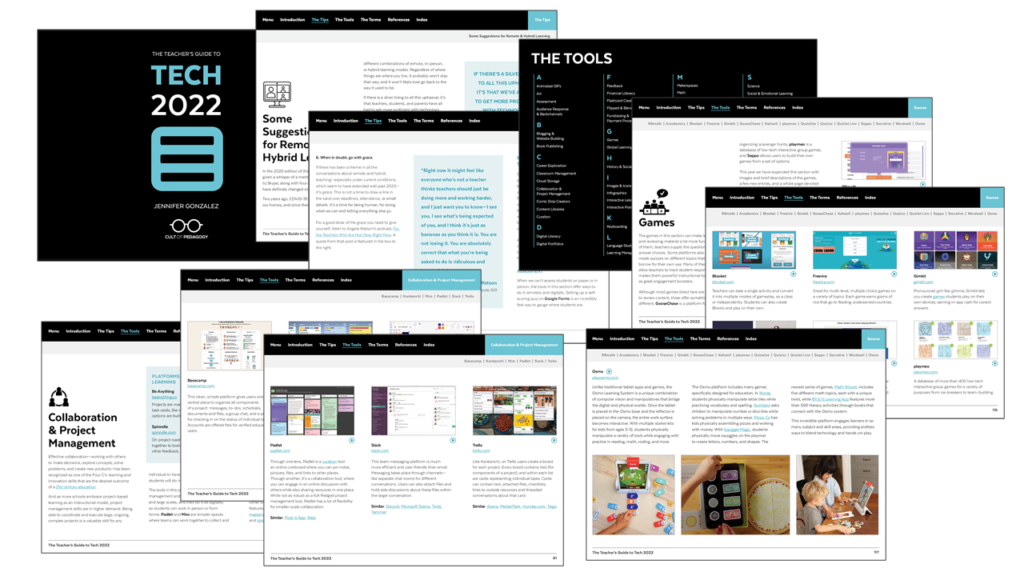
Listen to this post as a podcast:
Sponsored by Fearless Schools and Google’s Applied Digital Skills
In 2015, I published my very first Teacher’s Guide to Tech. I did it because teachers kept telling me that they wanted to use technology more effectively, but they were overwhelmed by the number of tools out there and the lack of time they had to research them and try them out. So they just kept using the same small handful of software applications, feeling more out of touch every year, watching their more tech-savvy peers lap them over and over.
I decided to try and make it easy on them. At first I thought I would just write a long blog post that put all the major educational tech tools into categories, explained what each one was, and linked to their sites. That quickly turned into a PDF that I called the Teacher’s Guide to Tech.
Now I’m releasing the 8th edition of that guide, the 2022 version, and what started as a catalog of just over a hundred tools has grown into an encyclopedia of over 500, with more than 50 different categories covering all subjects including art, physical education, and special ed, along with tools for classroom management, assessment, and feedback. There’s an extensive collection of resources for social justice and anti-racism, a huge section on makerspaces that includes coding, electronics, and robotics, tools for video editing, podcasting, media and news literacy, and social and emotional learning, and for every entry, just like in the first edition, there’s a picture of the tool in use and a link to a video that shows you how it works.
If this is the first time you’re hearing about the guide, here’s a quick video I made a few years ago to give you an idea of what it is and how it works:
Every year it takes a massive amount of time to update the guide—about three full months—because not only do I add new tools, but I also update all the stuff that changes: tools and websites change their names, they get absorbed by other companies, they shift their focus to something different, and sometimes they completely disappear. I look for the most updated videos, check that the photos are still accurate, and generally make sure everything is as up-to-date as possible, even though things will continue to change the day after the new guide is published!
This year, for the very first time, I hired a team of ed tech experts to help me with the update. The task was becoming overwhelming and I knew if I was going to keep it up, I had to have some help. Here they are below: Marnie Diem, Brandie Wright, Lucia Hassell, and Kim Darche.




In keeping with our yearly tradition, we’ll be sharing six tools we think are worth trying this year. Most are not brand-new, and some are not even new to the guide, but each one has something special about it that deserves a little extra attention. This year I have only chosen two of the six; the other four were chosen by my new team members. Here we go!
The Tools

1. Frame
The past two years have given us all more experience with video conferencing than we could have anticipated. While platforms like Zoom and Google Meet do a good enough job of letting us talk to each other, and even give us options for breaking larger meetings into smaller, more intimate groups, the experience is still kind of “flat.”
An emerging group of tools is trying to bridge that gap, using VR technology to create online spaces that feel more three-dimensional, allowing participants to move through virtual spaces as if they are physically in a room together. We feature five of these platforms in this year’s guide, and one of them is Frame. In the world of Frame, a host can create an environment like an office, a lounge, or even an island, and populate that environment with artwork, documents, videos, or any other kind of materials needed for a lesson or other experience. Participants move around the space as avatars and can use voice or text chat to interact.
There is definitely a learning curve with a platform like this, but it seems worth a try. The video below is more of an overview, but two videos from Greg Kulowiec—first this one, then this follow-up—provide a more in-depth look at how the platform works.

2. Google Arts & Culture Experiments
experiments.withgoogle.com/collection/arts-culture
This collection is a subset of Google’s larger Experiments platform, which is the result of Google allowing any coder with a creative idea to submit projects that use artificial intelligence, augmented reality, or any kind of code to stretch the limits of what technology can do. The Arts & Culture collection works with Google’s huge database of information about works of art, photography, and music.
This is a site worth visiting just for pure entertainment and curiosity, but it might end up lending itself to one of your lessons or inspiring students to try creating experiments of their own. If nothing else, it would be an excellent place to send students when they finish work early.
To experience them for yourself, try Puzzle Party, which takes fine art and breaks it into an interactive jigsaw puzzle you can do with friends, and Art Coloring Book, where you “color” famous works of art.

3. #1000BlackGirlBooks
marleydias.com/1000blackgirlbooks
This project started in November 2015, when elementary student Marley Dias decided to solve a problem. After noticing that very few of the books available to her and her peers featured Black female protagonists, she launched a campaign to change that. Since its inception, her goal to collect 1,000 books with Black girls as the main characters has surpassed itself. The collection now contains over 13,000 books.
To help users find books more easily, GrassROOTS Community Foundation has put the collection into a database where you can search by author and title or filter results by reading level.
This resource offers incredible value to all educators. English language arts teachers, school librarians, or anyone who maintains a classroom library can use the list to improve representation in their own materials. And any teacher or school leader committed to anti-racism can access the collection to find more books to read, books that celebrate and broaden readers’ understanding of the lives of Black girls and women.

4. Osmo
This device is so unique and flexible, we gave it its own full-page spread in the Games section of the guide.
Unlike traditional tablet apps and games, the Osmo Learning System is a unique combination of computer vision and manipulatives that bridge the digital and physical worlds. Once the tablet is placed in the Osmo base and the reflector is placed on the camera, the entire work surface becomes interactive. With multiple starter kits for kids from ages 3-12, students physically manipulate a variety of tools while engaging with practice in reading, math, coding, and more.
Having a system like this in your classroom would allow students to be more active and collaborative with their learning, rather than only interacting with a screen. The video below gives you an idea of how it works. To see it in action in other ways, watch more options like Math Wizard, Pizza Co, and Osmo’s coding games.

5. EVERFI
Originally a site that offered free financial literacy courses to students, EVERFI has expanded its course offerings to include career exploration (including one specific to STEM careers), social and emotional learning, diversity and inclusion, and health and wellness. Their newest additions are courses in healthcare literacy, data science and banking fraud, and compassion and empathy.
The lessons are gamified, putting students into simulated situations where they need to make decisions based on the concepts they are learning, and this keeps students engaged. Teachers are given analytics on student engagement and performance, so this is an ideal tool for use in remote and hybrid learning.
What’s great about the courses at EVERFI is that they hit on topics we often say should be taught in schools, but don’t often actually find in our curriculum. These lessons could be used in advisory periods, life skills classes, or as enrichment or independent study. Keep an eye on this site—they seem to be adding new materials all the time!

6. Skew the Script
The creators of this site are a group of math teachers who were tired of seeing their students drag themselves through contrived, irrelevant math problems. They wanted to write math problems that students actually cared about. With that in mind, Skew the Script was born, a site offering completely free, socially relevant math lessons for Algebra 1, Algebra 2 and AP Statistics.
There are lessons on lighter topics like sports, fast food, and pop culture, along with others on more serious issues like climate change, equity issues, gun control, and vaccinations. Lessons include videos, teacher slide decks, student handouts, and other resources to support teachers in face-to-face or online teaching.
Although they don’t currently have an explainer video to showcase their platform, the video below is one example of a statistics lesson. You can browse more videos on their YouTube channel.
The Teacher’s Guide to Tech
The 8th iteration of the Teacher’s Guide to Tech is loaded with tools that can enrich your teaching. With over 550 tools in over 50 different categories, this is the resource you need to quickly make smart decisions about the technology you choose for your classroom.
This year’s guide has over 115 new tools and three brand-new categories: Digital Literacy, Social & Emotional Learning, and Video Conferencing. Along with that, we’ve made sure that every single tool listed has up-to-date information, videos, and links to their sites, so you can find what you need and get back to teaching.

Where to Get Your Copy
Update: In January 2025, the Teacher’s Guide to Tech moved to an-online, subscription-based model. To subscribe please visit teachersguidetotech.com.


I am really looking forward to trying a few of these in my English classroom (particularly Frame and the Google Experiments). There are a number of tools on here that don’t apply, but I’ll be sure to share with my colleagues who could use them.
Tim, thanks for sharing with your colleagues, and we hope you find something useful for yourself as well!
I enjoyed the edition from last year and learned so much, I can’t wait to unpack this year’s guide. I will be sharing Everfi with my colleagues to determine how and when we can help districts implement Everfi into their supplemental practices and I will also be browsing it as a parent for use with my son!
That’s great to hear, Shalika! Jenn will be so pleased to know that you are finding so much value in the guide, both as a professional and as a parent!
Thank you for this list. Gladto see EverFi featured! Have you featured Lumio from SmartTech in the past? I’ll have to do some searching to find out… but I really like Lumio!
Superb podcast. Found it very helpful.
Thank you for this amazing list of resources! I must say that I have never heard of any of these besides Osmo, and I am really looking forward to exploring them with our teachers, particularly Everfi. As a Tech teacher who also made the transition from the technical side of schools (I was an IT manager for The American School of São Paulo for 17 years, now living and teaching in Shanghai) to the classroom, I really appreciate your work bringing to light so many great resources to educators everywhere in the world.
Thank you for these resources! I can see utilizing the Google Experiments (Learning and Digital Wellbeing ones for sure) in my science classes to increase engagement and offer new technology/ perspectives. I can not wait to share these with my fellow teachers. The Everfi lessons will be great for my colleagues who teach remote learning classes!
A few minutes ago, I posted links (on my Canvas modules page) to the puzzles and the frames, and all I can hear is crickets in my normally talkative gifted class of eighth graders. My most reluctant student just said, “Actually, this is kinda cool,” about the framevr.io site. Thank you so much for putting this podcast together. I’m going over to Teachable to get your guidebook now.
So glad to hear you found this useful!
Thank you for sharing so many new resources for educators. I am looking forward to using the 1000BLACKGIRLBOOKS resources to include in my curriculum.
Thanks so much for the resources! I’ve never heard of any of these, and I can’t wait to try some and share with my team. I can think of a few students who would LOVE the Google Arts and puzzles!
We’re so pleased to hear you find it useful!